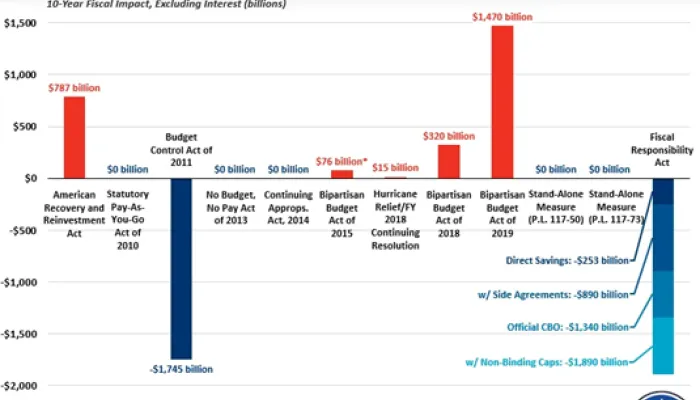Budget Reform: An Opportunity for Bipartisan Collaboration
Nearly a year ago, in its first report, Red Ink Rising, the Peterson-Pew Commission on Budget Reform raised the alarm about the impact of our exploding federal debt. Since then, the debt has reached a post-World War II high of more than 60 percent of GDP. Under reasonable assumptions about current and future policies, debt is projected to exceed 180 percent by 2040.
In Red Ink Rising we called on Congress to adopt a plan that would set a target for the federal debt at 60 percent of GDP, to be reached by 2018. A year later, Congress has not adopted any fiscal plan; nor has it even taken the smallest steps toward setting or meeting a multi-year target to stabilize the debt. This year it has done much less. It did not adopt a budget resolution, the standard annual spending blueprint, and has not sent the President any of the 12 spending measures required annually to authorize discretionary spending for the new fiscal year, which began October 1st.
Tomorrow the Commission is releasing its second report, Getting Back in the Black. This report will present a number of recommendations intended to put our budget process into shape to meet the fiscal challenges that are no longer on the horizon, but are now on our doorstep.
We propose changes to fix the broken budget process. These would provide incentives for the President and Congress to act in a timely and responsible way consistent with reaching a multi-year fiscal target, as well as automatic mechanisms that would kick in if they did not. Without implementing the changes recommended in our second report, we fear lawmakers will find it hard to act before the nation experiences a fiscal crisis or prolonged economic stagnation – either of which would make remedial action far more painful.
The reformed budget process outlined in Getting Back in the Black would help lawmakers direct resources to the highest priorities and the most cost-effective uses within a fiscal constraint. In constructing its proposed reforms, the Commission decided not to abandon the budget structure adopted as part of the 1974 Budget Act. Instead, we have adapted that basic underlying structure to reinforce the ability of leaders to manage the process and set priorities, to add a multi-year target and planning horizon, and to provide policymakers and the public better information about the tough choices they face in aligning spending and revenues to stabilize the federal debt. The resulting budget process would be more disciplined, more far-sighted, and more transparent.
Some will say that other, broader political reforms are needed. However, because of the urgency of budget process reform now and because other political reforms are not on the table, we limited our focus to what we believe can be accomplished within current political constraints.
Process reform cannot substitute for policy. Soon two other commissions will release recommendations that are expected to focus more on specific fiscal policies. But in the face of what could be continuing partisan gridlock, it may be easier for the President and Congress to get behind an early vote on a budget process reform package that includes a fiscal target and new budget procedures than to push through changes in Social Security or a complex tax reform package. The new budgeting framework recommended in Getting Back in the Black might be a rallying point for those who are divided on substantive issues but can agree that we need a budget process supportive of fiscal responsibility.


